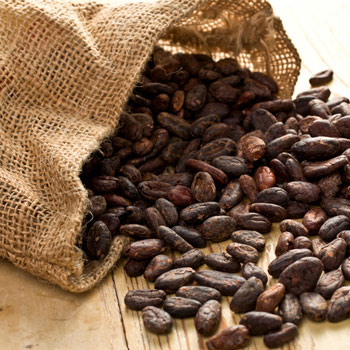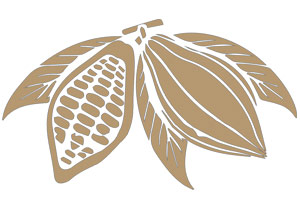
General presentation of cocoa and its uses:
Cocoa is a food product as well as a commodity traded on the stock markets. It is in fact an agricultural commodity that is one of the most traded food commodities worldwide.
Cocoa beans come from cocoa trees and are used in the food industry worldwide in a number of ways. They are in fact used for the production of chocolate after the cocoa beans have been ground. But other derived products are also manufactured from cocoa. This includes certain liqueurs, pastes, butter, cake and of course cocoa powder.
Currently, cocoa holds third position as one of the most traded commodities around the world.
More precisely, cocoa here relates to the powder obtained following the grinding of the cocoa beans which are the fruit of the cocoa tree. To better understand this market we can actually divide the cocoa industry into several distinct sectors as follows:
- The first part concerns the cocoa plantation operations as well as the harvest of the cocoa beans and their drying process. It is basically only the developing countries that are responsible for this primary industry.
- We then have the secondary phase which represents the transformation of the raw cocoa beans into cocoa fat or mass which is the semi-final product used by the chocolate industry. This procedure involves the beans going through certain processes including cleaning, drying, roasting, shelling and grinding. Sometimes these procedures take place directly at the production site but are mostly carried out by western multinational companies.
- Finally, the last part relates this time to the production of chocolate and other derived products that are then distributed to the final consumers. Of course, these secondary and third party activities are often completed in the consumer and developed countries.
Of course, it is necessary to bear in mind, between these stages, the transport industry and particularly the maritime transport which is predominantly used for transporting the cocoa.
Trade cocoa online!{etoroCFDrisk}% of retail CFD accounts lose money - etoro.com
What should I know before investing in cocoa?
As you have undoubtedly understood, the cocoa market is an international market that functions mostly in the same way as for other commodities quoted on the financial stock markets.
Concerning the production of cocoa, this is mainly in Africa, more precisely the Ivory Coast and Ghana which between them produce over 60% of the global production of cocoa. This represents more than 4 billion tons per year in fact. Other African countries also produce cocoa as well as certain South American and Indonesian countries. We also know that over 80% of the worldwide cocoa production is from family plantations which generally have a surface area of less than 10 hectares.
Concerning the final part of this industry, the processing and consumption of cocoa is higher in Europe and on the American continent. A large part of the global cocoa market of the finished product is in fact controlled by a few western multinational companies.
It should also be remembered that the global market is strongly influenced by the financial markets given that the physical trade prices and futures contracts for cocoa are fixed by the London and New York stock markets.
How is cocoa quoted on the stock markets and how is it traded?
Trading in cocoa, as with other agricultural food commodities, is completed over the counter as well as on certain regulated stock markets.
These markets are notably the NYMEX stock market, or New York Mercantile Exchange, that has been owned since 2008 by the Chicago Mercantile Exchange, and the LIFFE, or London International Financial Futures and Options Exchange.
It is therefore in the form of contracts that cocoa is traded on the markets. On the NYMEX the size of a standard contract is 10 tons. For the stock market quotation, the price for one ton of cocoa is quoted in American dollars with a minimum fluctuation of $1.
Trading in cocoa can be completed through futures contracts, options or derived products such as CFDs.
Of course, it is the supply and demand of cocoa that determines the price of this agricultural commodity. It is these phenomena that also determine the major movements in the long term trend of this asset price. A strong demand and a low supply will therefore lead to a higher price for cocoa and, to the contrary, a weaker demand and a higher supply will normally cause a drop in the price of this agricultural commodity.
How to invest and trade cocoa?
Cocoa is an agricultural commodity that is mainly grown in countries in West Africa, South America and Asia. This raw material is used to produce chocolate, cosmetics and other products.
Cocoa futures contracts allow investors to speculate on the future price of cocoa. These contracts are traded on commodity markets around the world, such as the NYMEX in New York or the ICE Futures Europe in London. Futures contracts have a specific expiry date, on which investors must buy or sell the agreed quantity of cocoa at the agreed price. Futures contracts can be a risky investment and require in-depth knowledge of the market.
Cocoa-linked ETFs offer a simpler option for investors who wish to invest in cocoa. These ETFs allow investors to buy a share of a portfolio of stocks of companies involved in the cocoa industry, or a cocoa futures fund. ETFs can be bought and sold on exchanges like stocks.
Investors can also buy shares in companies involved in the cocoa industry, such as producers, processors or distributors. It is important to understand the company's business, financial health and potential risks before investing in shares.
Cocoa CFDs are another option for investors who want to speculate on cocoa prices. CFDs are financial instruments that allow you to trade up or down in the financial markets. Cocoa CFDs are offered by many online brokers, but it is important to note that CFDs are a risky investment and require a thorough knowledge of the market.
Finally, currency trading is another way to speculate on cocoa, as the commodity is often traded in US dollars. Investors can buy or sell currency pairs, such as the US dollar and the Swiss franc, which are linked to the value of cocoa. Currency trading is also a risky investment and requires a thorough knowledge of the market.
In summary, there are several investment and trading options for cocoa, each with potential risks and benefits. Before making an investment decision, it is recommended that you do thorough research on the financial markets and consult a qualified financial advisor.
Trade cocoa online!{etoroCFDrisk}% of retail CFD accounts lose money - etoro.com
What is the historical trend in the price of cocoa?
Cocoa prices have been extremely volatile over the last 100 years. Here are a few key points
Early 20th century:
- Cocoa prices were relatively stable, with a slight upward trend.
- The First World War caused prices to rise, followed by a fall in the 1920s.
Great Depression:
- Cocoa prices fell dramatically, reaching their lowest level in 1932.
Second World War:
- Cocoa prices rose due to increased demand for chocolate.
Post-war period:
- Cocoa prices experienced a period of growth, peaking in 1977.
- The end of international cocoa agreements led to a fall in prices in the 1980s.
1990s and 2000s:
- Cocoa prices went through a period of volatility, peaking in 1995 and 2008.
- The 2008 financial crisis led to a fall in prices, followed by a recovery in the 2010s.
2020s:
- The COVID-19 pandemic disrupted cocoa markets and caused price volatility.
- The war in Ukraine led to a spike in cocoa prices in 2022.
Here is a summary table of cocoa price trends over the last 10 years:
| Year |
Average cocoa price (USD/tonne) |
Change from previous year |
| 2014 |
2 600 |
+8.3% |
| 2015 |
3 000 |
+15.4% |
| 2016 |
3 200 |
+6.7% |
| 2017 |
2 900 |
-9.4% |
| 2018 |
2 700 |
-6.9% |
| 2019 |
2 500 |
-7.4% |
| 2020 |
2 300 |
-8.0% |
| 2021 |
2 400 |
+4.3% |
| 2022 |
2 800 |
+16.7% |
| 2023 |
2 650 |
-5.4% |
The different types of cocoa price analysis
Before trading and investing in cocoa, it is strongly recommended that you carry out a full analysis. There are two major types of analysis for the cocoa price: technical analysis and fundamental analysis.
Technical analysis:
Technical analysis is based on the study of charts and historical data of the cocoa price to identify trends and patterns. Technical analysts use tools such as moving averages, momentum indicators and Japanese candlesticks to predict future price movements.
Fundamental analysis:
Fundamental analysis is based on the study of economic, political and social factors that influence the supply and demand of cocoa. Fundamental analysts look at factors such as global cocoa production, chocolate consumption, weather conditions, geopolitical events and government policies to predict long-term cocoa price movements.


